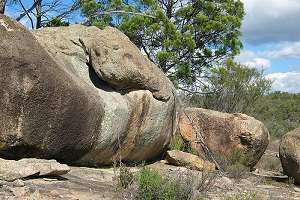Granite research revises heat under Perth's surface

Scientists investigating heat decay from radiogenic granite in the Darling Range have discovered the maximum heat output has exceeded previously known data.
Radiogenic granite, the major rock form of the Darling Range, is known for naturally high elemental concentrations of uranium (U), thorium (Th) and potassium (K).
During radioactive decay the elements release heat, and it is at depths of 3000–4000 metres that temperatures can attain 60 to 110C, making them viable for thermal applications.
Department of Mines and Petroleum research scientist Dr Mike Middleton says the thermal effect can also be observed at the base of a sedimentary rock layer, as is the case for the Perth Basin that lies over the Yilgarn Craton.
The Darling Range is at the boundary of both the Perth Basin and the Yilgarn Craton.
"In addition to establishing the amount of radiogenic heat generation in the Darling Range granites, the study was also about understanding the temperatures that might exist at depth in the Darling Range and adjacent Perth Basin," he says.
Measuring exposed granite at 13 sites across the Darling Range using a Geiger Muller counter and RS 125 Spectrometer Dr Middleton and his team were able to model the data as an estimation of heat production.
Results indicate providing a uniform thickness in the granite profile (of 6km), heat generation can be within the vicinity of 50C at 1000m, 75C at 2000m, 100C at 3000m and 120C at 4000m.
Despite these geothermally considered lower temperatures Dr Middleton says this, "has a significant role to play in Perth's energy mix, albeit with low-temperature applications".
"The high radiogenic heat generation in the Darling Range appears to be the cause of the hot water within the Perth Basin, as the granites of the Darling Range extend under the Perth Basin, which provides the sedimentary blanket."
"Indeed, hot water springs were noted in Dalkeith, near the Swan River, back in the early 1900s."
Metropolitan Perth is ideally situated to take advantage of the low temperature geothermal energy, especially by the use of organic Rankine-cycle turbines or absorption chillers that operate at 70–120C.
"A current study is being carried out in the Vasse region, where hot pools and natural hot springs may be developed to support the tourist industry, especially in the colder months of the year," he says.
Geothermal potential may also occur in Albany and Esperance.
Dr Middleton says studies are continuing in the regions south of Perth.
Provided by Science Network WA



















